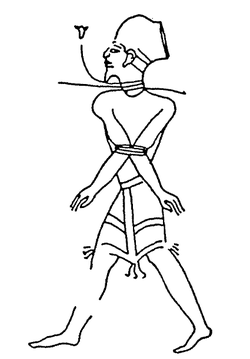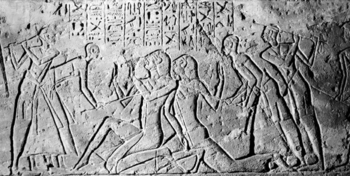Shasu
The Shasu (from Egyptian š3sw, probably pronounced Shaswe[1]) were Semitic-speaking cattle nomads in the Southern Levant from the late Bronze Age to the Early Iron Age or the Third Intermediate Period of Egypt. They were organized in clans under a tribal chieftain, and were described as brigands active from the Jezreel Valley to Ashkelon and the Sinai.[2]

Some scholars link the Israelites and YHWH with the Shasu.
Etymology
The name's etymon may be Egyptian š3sw, which originally meant "those who move on foot". Levy, Adams, and Muniz report similar possibilities: an Egyptian word that means "to wander", and an alternative Semitic one with the meaning "to plunder".[3]
History
The earliest known reference to the Shasu occurs in a 15th-century BCE list of peoples in the Transjordan region. The name appears in a list of Egypt's enemies inscribed on column bases at the temple of Soleb built by Amenhotep III. Copied later in the 13th century BCE either by Seti I or by Ramesses II at Amarah-West, the list mentions six groups of Shasu: the Shasu of S'rr, the Shasu of Rbn, the Shasu of Sm't, the Shasu of Wrbr, the Shasu of Yhw, and the Shasu of Pysps.[4][5]
Shasu of Yhw

Two Egyptian texts, one dated to the period of Amenhotep III (14th century BCE), the other to the age of Ramesses II (13th century BCE), refer to "Yahu in the land of the Šosū-nomads" (t3 š3św yhw[6]), in which yhw[3]/Yahu is a toponym.
| Hieroglyph | Name | Pronunciation | |||
|---|---|---|---|---|---|
| N16 | ta ("land") | ||||
| M8 | ša | ||||
| M23 | sw | ||||
| w | w | ||||
| y | y | ||||
| h | h | ||||
| V4 | wa | ||||
| w | w |
Regarding the name yhw3, Michael Astour observed that the "hieroglyphic rendering corresponds very precisely to the Hebrew tetragrammaton YHWH, or Yahweh, and antedates the hitherto oldest occurrence of that divine name – on the Moabite Stone – by over five hundred years."[7] K. Van Der Toorn concludes: "By the 14th century BC, before the cult of Yahweh had reached Israel, groups of Edomites and Midianites worshipped Yahweh as their god."[8]
Donald B. Redford has argued that the earliest Israelites, semi-nomadic highlanders in central Palestine mentioned on the Merneptah Stele at the end of the 13th century BCE, are to be identified as a Shasu enclave. Since later Biblical tradition portrays Yahweh "coming forth from Seʿir",[9] the Shasu, originally from Moab and northern Edom/Seʿir, went on to form one major element in the amalgam that would constitute the "Israel" which later established the Kingdom of Israel.[10] Per his own analysis of the el-Amarna letters, Anson Rainey concluded that the description of the Shasu best fits that of the early Israelites.[11] If this identification is correct, these Israelites/Shasu would have settled in the uplands in small villages with buildings similar to contemporary Canaanite structures towards the end of the 13th century BCE.[12]
Objections exist to this proposed link between the Israelites and the Shasu, given that the group in the Merneptah reliefs identified with the Israelites are not described or depicted as Shasu (see Merneptah Stele § Karnak reliefs). The Shasu are usually depicted hieroglyphically with a determinative indicating a land, not a people;[13] the most frequent designation for the "foes of Shasu" is the hill-country determinative.[14] Thus they are differentiated from the Canaanites, who are defending the fortified cities of Ashkelon, Gezer, and Yenoam; and from Israel, which is determined as a people, though not necessarily as a socio-ethnic group.[15][16] Scholars point out that Egyptian scribes tended to bundle up "rather disparate groups of people within a single artificially unifying rubric."[17][18]
Frank J. Yurco and Michael G. Hasel would distinguish the Shasu in Merneptah's Karnak reliefs from the people of Israel since they wear different clothing and hairstyles, and are determined differently by Egyptian scribes.[19] Lawrence Stager also objected to identifying Merneptah's Shasu with Israelites, since the Shasu are shown dressed differently from the Israelites, who are dressed and hairstyled like the Canaanites.[20][21]
The usefulness of the determinatives has been called into question, though; it has been pointed out that in Egyptian writings, including the Merneptah Stele, determinatives are used arbitrarily.[22] Moreover, the hill-country determinative is not always used for Shasu, as is the case in the "Shasu of Yhw" name rings from Soleb and Amarah-West. Gösta Werner Ahlström countered Stager's objection by arguing that the contrasting depictions are because the Shasu were the nomads, while the Israelites were sedentary, and added: "The Shasu that later settled in the hills became known as Israelites because they settled in the territory of Israel".[21]
See also
References
Inline citations
- Donald B. Redford (1992), p. 271.
- Miller (2005), p.95
- Levy, Adams, and Muniz, p. 66
- Sivertsen (2009), p. 118
- Hasel (1998), p. 219
- Horn, Siegfried - (1953). "Jericho in a Topographical List of Ramesses II", Journal of Near Eastern Studies 12: 201-203.
- Astour (1979), p. 18
- K. Van Der Toorn, p. 282-283
- Book of Judges, 5:4 and Deuteronomy, 33:2
- Donald B. Redford (1992), p. 272–3,275.
- Rainey (2008)
- Shasu, in Ian Shaw, Robert Jameson (eds) Dictionary of Archaeology, John Wiley & Sons, 2008 p.313.
- Dermot Anthony Nestor, p.185.
- Hasel (2003), p. 32–33
- Stager (2001), p. 92
- Kenton L. Sparks, p.108
- Nestor, p.186.
- Sparks, p. 105−106
- Yurco (1986), p. 195, 207; Hasel (2003), p. 27–36.
- Stager (2001), p. 92
- Ahlström, pp. 277–278, note 7
- Miller (2012), p. 94
Sources referenced
- Ahlström, Gösta Werner (1993). The History of Ancient Palestine. Fortress Press. ISBN 978-0-8006-2770-6.
- Astour, Michael C. (1979). "Yahweh in Egyptian Topographic Lists." In Festschrift Elmar Edel, eds. M. Gorg & E. Pusch, Bamberg.
- Dever, William G. (1997). "Archaeology and the Emergence of Early Israel" . In John R. Bartlett (Ed.), Archaeology and Biblical Interpretation, pp. 20–50. Routledge.
- Hasel, Michael G. (1994). "Israel in the Merneptah Stela," Bulletin of the American Schools of Oriental Research, No. 296, pp. 45–61.
- Hasel, Michael G. (1998). Domination and Resistance: Egyptian Military Activity in the Southern Levant, 1300–1185 BC. Probleme der Ägyptologie 11. Leiden: Brill, pp. 217–239. ISBN 90-04-10984-6
- Hasel, Michael G. (2003). "Merenptah's Inscription and Reliefs and the Origin of Israel" in Beth Alpert Nakhai ed. The Near East in the Southwest: Essays in Honor of William G. Dever, pp. 19–44. Annual of the American Schools of Oriental Research 58. Boston: American Schools of Oriental Research. ISBN 0-89757-065-0
- Hoffmeier, James K. (2005). Ancient Israel in Sinai, New York: Oxford University Press, 240–45.
- Horn, Siegfried H. (1953). "Jericho in a Topographical List of Ramesses II," Journal of Near Eastern Studies 12: 201–203.
- Levy, Thomas E.; Adams, Russell B.; Muniz, Adolfo (January 2004). "Archaeology and the Shasu Nomads". In Richard Elliott Friedman; William Henry Propp (eds.). Le-David Maskil: A Birthday Tribute for David Noel Freedman. Eisenbrauns. pp. 66–. ISBN 978-1-57506-084-2.
- MacDonald, Burton (1994). "Early Edom: The Relation between the Literary and Archaeological Evidence". In Michael D. Coogan, J. Cheryl Exum, Lawrence Stager (Eds.), Scripture and Other Artifacts: Essays on the Bible and Archaeology in Honor of Philip J. King, pp. 230–246. Louisville, KY: Westminster John Knox Press. ISBN 0-664-22364-8
- Miller (II.), Robert D. Chieftains of the Highland Clans: A History of Israel in the 12th and 11th Centuries B.C., Wm. B. Eerdmans Publishing, 2005, Wipf and Stock Publishers, 2012
- Nestor, Dermot Anthony, Cognitive Perspectives on Israelite Identity, Continuum International Publishing Group, 2010
- Rainey, Anson (2008). "Shasu or Habiru. Who Were the Early Israelites?" Biblical Archaeology Review 34:6 (Nov/Dec).
- Redford, Donald B. (1992). Egypt, Canaan and Israel In Ancient Times. Princeton: Princeton University Press. ISBN 0-691-00086-7.
- Sivertsen, Barbara J. The Parting of the Sea: How Volcanoes, Earthquakes, and Plagues Shaped the Story of Exodus. Princeton University Press, 2009. ISBN 978-0-691-13770-4
- Sparks, Kenton L., Ethnicity and Identity in Ancient Israel: Prolegomena to the Study of Ethnic Sentiments and Their Expression in the Hebrew Bible, Eisenbrauns, 1998, p. 108: 'If the Egyptian scribe was not clear on the nature of the entity he called "Israel," knowing only that it was "different" from the surrounding modalities, then we can imagine something other than a sociocultural Israel. It is possible that Israel represented a confederation of united, but sociologically distinct, modalities that were joined either culturally or politically via treaties and the like. This interpretation of the evidence would allow for the unity implied by the endonymic evidence and also give our scribe some latitude in his use of the determinative'.
- Stager, Lawrence E. (2001). "Forging an Identity: The Emergence of Ancient Israel". In Michael Coogan (Ed.), The Oxford History of the Biblical World, pp. 90–129. New York: Oxford University Press. ISBN 0-19-508707-0
- van der Toorn, K. (1996). Family Religion in Babylonia, Ugarit and Israel: Continuity and Changes in the Forms of Religious Life (BRILL)
- Yurco, Frank J. (1986). "Merenptah's Canaanite Campaign." Journal of the American Research Center in Egypt 23:189–215.